Steel scaffolding is a temporary structure of steel tubes and fittings assembled to create a framework for construction, maintenance, and repair projects. Steel scaffolds are widely used for their strength, durability, and resistance to harsh weather conditions such as heavy rain and wind. These days, modern modular steel scaffolds can be customized for different layouts, making this scaffold highly adaptable for various building sizes and shapes.
The main types of steel scaffolding are single steel scaffold, double steel scaffold, cantilever scaffold, suspended scaffold, and portable steel scaffolding. The primary benefits of steel scaffolding are durability, strength, heavy load-bearing capacity up to 800 KN, and reusability. The primary uses of steel scaffolding are facade work, structural work, high-rise construction, demolition support, repair, and maintenance. Steel scaffolding is a reliable and durable solution used in various construction projects due to its long-term cost-effectiveness and durability.
Table of Contents
What is Steel Scaffolding?
Steel scaffolding is a provisional framework constructed using strong and resilient steel tubes, which are securely linked together via couplers or fittings to provide stable support during construction, maintenance, or repair work. Steel Scaffolding is a temporary structure that is typically made from metal poles and wood planks, known for its strength and reliability. This temporary structure can withstand harsh weather conditions and carry heavy loads effortlessly. Steel scaffolds are highly versatile; you can easily adjust them to different heights and configurations. Contractors prefer to invest in this type of scaffolding as they can use the same structure repeatedly, allowing them to get long-term returns on investment.
Steel Scaffolding images


What are the types of Steel Scaffolding?
The eight primary types of steel scaffolding are as follows:
- Single steel scaffolding
- Double steel scaffolding
- Cantilever scaffolds
- Suspended Steel Scaffolding
- Portable Trestle Steel Scaffolding (A-frame)
- Rolling and Mobile Steel Scaffolding Tower
- Staircase Steel Scaffolding
- Shoring Steel scaffolding
1. Single Steel Scaffolding
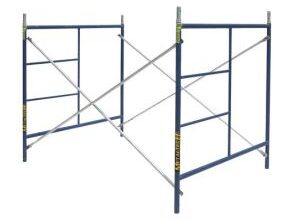
Single steel scaffolding is a simple framework consisting of a single row of vertical steel standards or poles connected with horizontal ledgers. Transoms are placed across ledgers to create a stable working platform. This type of steel scaffolding is used for brickwork and light-duty applications.
2. Double Steel Scaffolding

Double steel scaffolding is designed with double rows of scaffolding structures connected with cross braces and ledgers. It is an independent steel scaffolding system primarily used for stonework.
3. Cantilever Steel Scaffolding

Cantilever steel scaffolding is designed with cantilever beams supported through the needles extending out of the structure. It is an ideal type of steel scaffolding for narrow spaces where it’s not possible to have some ground support for the scaffold structure.
4. Suspended Steel Scaffolding
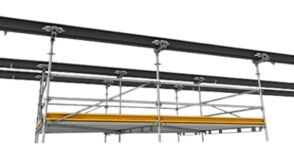
Suspended scaffolding is suspended from the top of the structure through wires, ropes, or chains. You can adjust the height of the platform through pulleys. It is designed to perform maintenance tasks, such as painting and window cleaning on high-rise buildings and tall structures.
5. Portable Trestle Steel Scaffolding (A-frame)
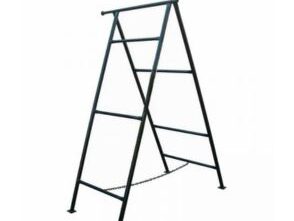
Portable Trestle Steel scaffolding comprises two steel A-shaped frames that support the working platform. This A-Frame scaffold is lightweight and portable. It is used for interior work like painting, repair, decorating, and plastering at low heights.
6. Rolling and Mobile Steel Scaffolding Tower

Rolling and Mobile steel scaffolding consists of vertical standards, braces, and ledgers with a platform on the top and wheels at the base. Mobile steel scaffolding towers are easy to reposition due to wheels and help perform electrical component installation and ceiling work.
7. Staircase Steel Scaffolding
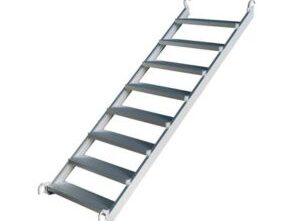
A staircase steel scaffolding has a scaffold structure with a staircase that allows workers to access different levels of the building safely. This type of steel scaffolding is ideal for projects requiring constant movements and access to elevated building levels.
8. Shoring Steel Scaffolding
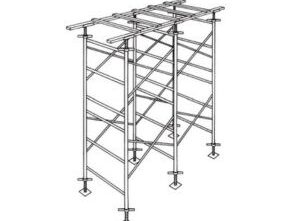
Shoring steel scaffolding comprises heavy-duty steel parts and cross braces for excellent stability and support. It is used in construction projects requiring temporary reinforcement for structural integrity, such as structural changes or demolition projects.
What are the advantages of Steel Scaffolding?
The 9 advantages of steel scaffolding are as follows:
- High Strength
- Load-Bearing Capacity
- Durability
- Reusable
- Easy Assembly and Dismantling
- Stability
- Eco-Friendly
- Cost-Effective
- Versatility
High Strength: The most significant benefit of steel scaffolding is its exceptional strength and heavy load-bearing capacity. Therefore, it is pretty suitable for large-scale construction and complex projects.
2.Load-Bearing Capacity: Another benefit of steel scaffolding is that it offers a load capacity of up to 800 KN. Whenever a project involves multiple workers, heavy materials, and equipment, a steel scaffold provides optimal load support while ensuring excellent safety and stability.
3. Durability: Steel scaffolding is made from steel, which is a highly durable material with 20-50 years of long life span. It can withstand harsh weather conditions while showing excellent resistance to wear and tear. Its high durability provides the best value for the money. Construction managers must spend cash on steel scaffolding once they can use it for multiple projects. There is no need to replace this scaffold frequently for other structures.
4. Reusable: Another plus point of steel scaffolding is using it repeatedly. Its high reusability reduces waste, as with single-use scaffold materials.
5. Easy Assembly and Dismantling: Steel scaffolding has a modular design with semi-assembled or pre-assembled components. As a result, you can put the whole scaffold structure together in less time and with great ease. It improves project efficiency and reduces effort from your side.
6. Stability: Another benefit of steel scaffolding is that it offers a stable working platform for workers. Steel is a rigid material that allows workers to stand on a strong platform and perform tasks.
7. Eco-Friendly: Steel is a recyclable material. You can use this scaffold to reduce the environmental impact.
8. Cost-Effective: First, you must invest significantly in steel scaffolding, which helps you reap a long-term return. Its high durability, longevity, and reusability make it a cost-effective option in the long run. There is no need to invest money in replacing this scaffolding or frequently spend money on its repair.
9. Versatility: Another plus point of steel scaffolding is its versatility. You can adjust its height, access points and shape per project requirements. Its wide customization options make it ideal for different construction projects.
What are the disadvantages of Steel Scaffolding?
The seven disadvantages of steel scaffolding are as follows
- Heavy Weight
- Corrosion
- High Initial Cost
- Space Requirement
- Electric Conductivity
- Maintenance
- Environmental Impact
- Heavy Weight: Steel is a heavy-weight material, so scaffolds made of scaffold are also very heavy. Workers need help to transport, handle or erect them. There is a need for more workers who can handle the load during installation.
- Corrosion: Another disadvantage of steel is that it is highly susceptible to corrosion, especially in harsh weather conditions where salt air, chemicals, and moisture are present. Even when steel-made scaffolds are painted and galvanized for protection, they are still prone to damage that requires costly repair or replacement.
- High Initial Cost: Steel scaffold is expensive and requires high initial investment for complex and large projects. This high cost makes it less suitable for small firms and low-budget projects where you must make the most of limited resources.
- Space Requirement: Another disadvantage of steel scaffolding is that it requires more space for transport, assembly, and storage. Therefore, more suitable scaffold structures exist in limited spaces or congested areas like urban environments.
- Electrical Conductivity: Electrocution risk is another drawback of steel scaffolding. Steel is an excellent conductor of electricity and causes serious safety hazards regarding power lines and electrical components.
- Maintenance: Another disadvantage of steel scaffolding is that it requires constant inspection, maintenance, and cleaning to maintain structural integrity. The cost and complexity of scaffold structures increase as more labour is needed for installation.
- Environmental Impact: The biggest drawback of steel is that its production involves extensive carbon dioxide emission, high energy consumption and requires too many resources to extract its raw materials.
What are the uses of steel scaffolding?
The eight uses of steel scaffolding are as follows:
- Facade Work
- Structural Work
- High-Rise Construction
- Maintenance and Repairs
- Painting and Cleaning
- Renovation Projects
- Building Extensions
- Demolition Support
Facade Work

Steel scaffolding is mainly used for facade work such as decoration, repair, and installation of external walls and windows. Workers can easily use this stable platform to access different building levels. Steel scaffolding is a strong structure that supports heavy tools, machinery, and equipment during various construction tasks.
Structural Work

Steel scaffolding supports structural work, such as erecting beams and installing slabs or columns at different heights. It is a strong scaffold structure that can handle heavy loads and equipment during structural construction projects.
High-Rise Construction

The most significant use of steel scaffolding is in high-rise construction projects. It offers considerable flexibility and stability, which are requisite for such projects. Workers can easily install and dismantle its modular design and adjust its height effortlessly. This durable and heavy-duty scaffolding proves effective in such a demanding scenario whenever there is a task of bricklaying, plastering, plumbing or electric system installation.
Maintenance and Repairs

Steel scaffolding can be used for minor or extensive maintenance tasks. This structure provides easy access to difficult-to-reach areas and lets workers easily perform repair and maintenance tasks. You can use steel scaffolds to fix pipelines, replace damaged sections, and repair roofs.
Painting and Cleaning

Steel scaffolding is mainly used to paint and clean large machinery, bridges, and tall buildings. It offers a stable working platform that workers can use. Besides, it supports painting and cleaning components like heavy paint buckets and sprayers.
Renovation Projects

Steel scaffolding is quite a vital structure to use during building renovation projects. It allows workers to access different parts of the building that need upgrades and renovation. You can install this structure around existing structures without causing any damage to old and historic buildings
Building Extensions

Steel scaffolding provides the required support for the construction of building extensions, and at the same time, it ensures that existing structures are safe. You can easily do building extension tasks in tight spaces and at elevated heights through steel scaffolds.
Demolition Support

Steel scaffolding is also used during the demolition process. It offers temporary support to the structure that needs to be taken down. This structure makes the demolition process smoother and more controlled while protecting the workers and nearby areas from falling debris.
What are the parts of Steel scaffolding?
The twelve parts of steel scaffolding are as follows:
- Base Plates
- Standards
- Ledgers
- Transoms
- Bracing
- Platform/Decking
- Couplers
- Toe Boards
- Guard Rails
- Sole Boards
- Clamps
- Ties

1. Base Plates:
Base plates are flat steel plates installed at the bottom of standards in steel scaffolding. These plates provide stability to the structure while distributing the load evenly to the ground. Some base plates have holes so that you can fix them to the ground, especially when erecting scaffolding on uneven terrain.

2. Standards:
Standards are vertical steel poles of steel scaffolding structure. They are connected at regular intervals through transoms and ledgers. They transfer the structure weight from the platform toward the base plates and eventually to the grounds.
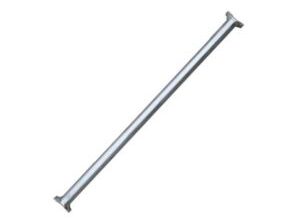
3. Ledgers:
Ledgers are horizontal steel tubes connected to the standards and run parallel to the building. Ledgers offer support for transoms and platforms while providing lateral support to steel scaffolds.
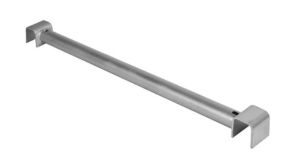
4. Transoms:
Transoms are horizontal steel components that are placed across ledgers. They support the platform deck and enhance the stability level of the entire steel scaffold framework.
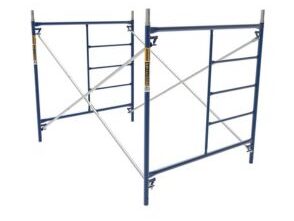
5. Bracing:
Bracing is the diagonal part of steel scaffolding. Braces are used to connect ledgers, standards, and transoms. They prevent the structure from swaying and collapsing while offering the utmost stability.
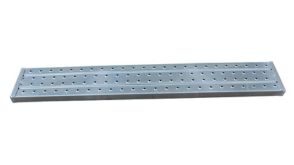
6.Platform/Decking:
A platform is a horizontal working surface where workers stand and put their materials, tools, and equipment. The platform is usually made of steel or wood.
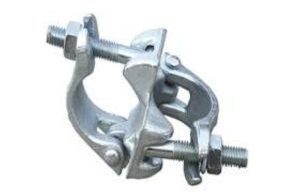
7. Couplers:
Couplers are metal clamps used to join different steel scaffolding components together. Other types of couplers, such as swivel couplers, sleeve couplers, right-angle couplers, etc., are available per project requirements.

8. Toe Boards:
Toe boards are small vertical barriers installed at the platform’s edge. They are safety components of steel scaffolds as they prevent tools or materials from slipping off the structure. Toeboards are also essential for the safety of pedestrians and workers at ground level because any tool falling off the platform may lead to personal injury.
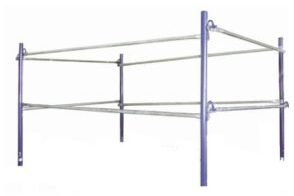
9. Guard Rails:
Guard rails are horizontal safety steel tubes installed at the platform’s edges. They prevent workers from falling. Usually, double guardrails are used in steel scaffolding. A top rail is placed at waist height, while a mid-rail is installed to boost worker safety.
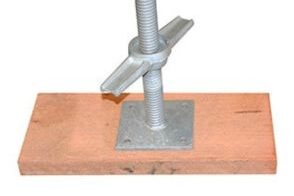
10. Sole Boards:
Sole boards are placed beneath the base plates on soft or uneven ground. These boards are made of wood or steel planks. They keep the steel scaffold structure stable on uneven terrain while distributing its overall load and preventing sinking.
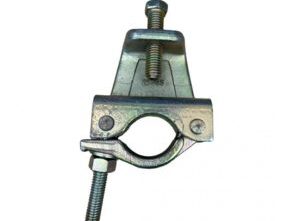
11. Clamps:
Clamps are devices used to secure the scaffolding components together. They reduce the risk of accident and structural detachment by enhancing system strength.
12. Ties:

Ties are used to secure steel scaffolds with their supported structure. Ties are crucial steel scaffolding components, especially when a structure needs to be built for taller buildings. They prevent scaffolds from moving away from the building.
Which Steel scaffolding materials are used in the construction?
The following are 29 steel scaffolding materials used in the construction:
- Modular Steel Scaffolding
- Ringlock scaffolding
- Cuplock scaffolding
- Kwikstage scaffolding(quick stage)
- Quick lock scaffolding
- Quick erect scaffolding
- Tube lock Scaffolding (steel tube with fittings)
- Speedshore scaffolding
- Crab 60 shoring system
- 60mm Heavy-duty ring lock system
- Steel Tube and Clamps
- OD48.3×4.0mm Type 4 Scaffold Tube + Drop Forged Scaffolding Couplers
- OD48.3×3.2mm Type 3 Scaffold tube + Forged & pressed scaffold clamps BS1139
- OD48.6×2.4mm JIS /KS Standard Scaffolding Pipes + JIS and Korean Scaffolding Clamps
- Adjustable props
- Lightweight Shoring Props
- Medium-duty steel Props
- Heavy Duty Scaffold Props
- Frame Scaffolding
- Walk through frame scaffold
- Ladder-frame scaffolding
- Shoring frame scaffolding
- V shore scaffolding
- Column frame scaffolding
- H-frame scaffold
- Steel boards and steel stairs
- Steel battens or metal decks without hooks to fixed by board clamps
- Steel planks with hooks and sit on horizontal parts
- Steel stairs from access ways
1. Modular Steel Scaffolding
Modular steel scaffolding is made of pre-fabricated steel components that you need to put together to erect this scaffolding quickly. The whole system comprises horizontal ledgers, vertical standards, and diagonal braces. The system offers high load-bearing capacity and is easy to use and assemble. Therefore, it is an ideal steel scaffolding for large-scale construction projects.
2. Ringlock Scaffolding
Ringlock scaffolding is an advanced modular steel scaffold with a central ring connecting various components, such as ledgers, standards, and braces, at multiple angles. This versatile system has high load-bearing capacity and offers quick assembly. It is commonly used for medium-duty construction projects, industrial plants, and event staging.
3. Cuplock Scaffolding
Cuplock scaffolding is another modular steel system scaffold with cup joins connecting horizontal and vertical components. There are top and bottom cups where you need to insert horizontal and vertical parts and lock them in place through a simple twist. They are mainly used for high-rise buildings, bridges, and curved structures.
4. Kwikstage Scaffolding (Quick Stage)
Kwikstage scaffolding has a wedge connector used to build a secure framework with a high stability level. It is designed with a vertical standard featuring built-in v-locks. These locks attach transoms and horizontal ledgers. It is a super adaptable modular steel scaffold system used for facade, brickwork, and building maintenance.
5. Quick Lock Scaffolding
Quick lock scaffolding offers quick assembly and an efficient locking mechanism to keep horizontal and vertical parts of the scaffold secure in place. You can use this scaffolding for small to medium-sized construction projects with tight schedules and high-efficiency work requirements.
6 . Quick Erect Scaffolding
A quick erect scaffolding system consists of pre-assembled parts that allow you to erect scaffolding quickly. You can use this scaffolding for projects with tight deadlines, short-term applications and where you need to perform repetitive tasks.
7. Tube Lock Scaffolding (Steel Tube with Fittings)
Tube lock scaffolding is made of steel tubes connected with steel couplers. This flexible system is customizable as tubes can be cut to align with various lengths required in the projects.
8. Speedshore Scaffolding
Speedshore scaffolding is a lightweight shoring system made from a high-strength steel frame and adjustable parts. It is simple to install and used for underground construction, trench shorting, and excavation support.
9. Crab 60 Shoring System
The Crab 60 shoring system is a modular steel scaffolding system made from heavy-duty steel. It comprises adjustable frames, high-load bearing components, and 60mm tubes. This overall system is suitable for supporting heavy structural loads, beams, and slabs during construction.
10.60mm Heavy-Duty Ring Lock System
The 60mm heavy-duty ring lock system is designed with steel tubes and a central rosette to keep components together. The best thing about this system is that it supports heavy loads and provides top-level stability for high-load construction projects.
11. Steel Tube and Clamps
Steel tubes and clamp scaffolding comprise steel pipes that are joined with couplers and clamps. These tubes can be customized to different lengths and angles to meet the requirements of a complex project. They are super adaptable and, therefore, widely used in repair, maintenance, and construction projects where customization is required.
12. OD48.3×4.0mm Type 4 Scaffold Tube + Drop Forged Scaffolding Couplers
This type 4 Scaffold tube has a diameter of 48.3mm and around a 4.0mm wall thickness. Type 4 scaffold tubes alongside drop-forged scaffolding couplers are highly reliable and have strong connections. They are often used for heavy-duty applications where high load capacity is a requisite.
13.OD48.3×3.2mm Type 3 Scaffold Tube + Forged & Pressed Scaffold Clamps (BS1139)
The type 3 tube system comprises 48.3mm diameter tubes with a wall thickness of 3.2mm while the scaffold clamp meets British Standards (BS1139). This steel system is suitable for medium-scale construction projects where high quality and safety is a requisite.
14. OD48.6×2.4mm JIS / KS Standard Scaffolding Pipes + JIS and Korean Scaffolding Clamps
These steel scaffolding pipes are designed by following Japanese Industrial Standards (JIS) and Korean Standards (KS) and are featured with clamps that secure the pipes and keep them in place. Compliance with such standards makes them safe and reliable pipes and clamps for lightweight construction projects.
15. Adjustable Props
Adjustable props are telescopic steel components that provide temporary vertical support. These props consist of inner and outer tubes. Usually, the inner tube is slid over the outer to simplify the adjuster is a pin or screw jack that works as a locking mechanism for the prop. These props support beams, walls, and slabs during construction.
16. Lightweight Shoring Props
Lightweight shoring props are made from thin and strong steel material. The purpose of using a thin steel sheet is to reduce the weight while the structural stability of the props remains intact. These lightweight props are easy to transport and are used mainly in renovation and construction projects where efficiency and mobility are necessary.
17. Medium-duty Steel Props
Medium-duty steel props are made from thicker steel, and their load capacity is higher than that of lightweight props. They offer a significant amount of stability under heavy load scenarios. The high stability of steel props makes them ideal materials for medium to large-scale industrial and construction projects.
18. Heavy Duty Scaffold Props
Heavy-duty steel scaffold props are strong, durable, and adjustable supports used in heavy-duty construction tasks. They have a heavy load capacity and can be customized for different applications.
19. Frame Scaffolding
Frame steel scaffolding constituents of two vertical frames connected through horizontal cross braces. They are designed for easy assembly and dismantling. Frame scaffolding is used at construction sites that require more workers to move around.
20. Walk Through Frame Scaffold
The walk-through frame scaffold is designed to make the passage of workers convenient throughout the structure. The scaffold frame has an ample vertical clearance. It is used in construction sites where workers frequently access different building parts.
21. Ladder-Frame Scaffolding
Ladder-frame scaffolds integrate a ladder into the scaffold. This specific structure prevents the need for additional ladder installation. Workers can access different levels of the building through this scaffold. It is instrumental in limited space.
22. Shoring Frame Scaffolding
Shoring frame scaffolding is designed to support weight over it. They are robust structures that can carry heavy loads. They are generally used to support structures and buildings during repair and alteration.
23. V Shore Scaffolding
V-shore steel scaffolding has a V-shaped configuration of a robust steel frame that supports two walls and structures. It is used as a temporary structure during structural adjustment and proves effective in building renovation.
24. Column Frame Scaffolding
Column frame scaffolding has a rectangular, modular structure that circles the column. It is commonly used for constructing, repairing, and maintaining columns and pillars.
25. H-Frame Scaffold
H-Frame scaffold is a ladder-like, H-shaped structure connected by cross braces. It offers a stable working platform. H-frame scaffolding is commonly used for painting, plastering, and facade work.
26. Steel Boards and Steel Stairs
Steel boards are a safe and durable platform, while steel stairs provide secure access to workers at elevated levels.
27. Steel Battens or Metal Decks Without Hooks
Steel battens are flat metal platforms used as a base for workers and materials on a scaffolding structure. Since they are without hooks, board clamps are typically used to fix these metal decks in their proper position. They provide a secure platform for workers.
28. Steel Planks with Hooks
Steel planks are placed on the horizontal parts of the scaffolding and secured through hooks to enhance structural stability. They are used to create a stable work platform. They ensure proper distribution of weight alongside secure footing.
29. Steel Stairs for Access Ways
Steel stairs are steel-made stairs that offer easy access to various levels of scaffolding structures. They make vertical movement efficient and safe in tall steel scaffolding structures.
How is Bamboo Scaffolding compared to Steel Scaffolding?
Here is a table comparing bamboo scaffold to steel scaffolding.
| Bamboo Scaffolding | Steel Scaffolding |
| Made from natural bamboo poles | Made from steel components |
| Lightweight and less stronger than steel, suitable for light loads | Heavy-duty, stronger than bamboo, and support heavy loads |
| Takes more time to assemble as they require extensive fittings | Less durable, prone to weathering, rot, and decay over time |
| Cheaper than steel as bamboo is widely available | Expensive |
| Less stable than steel as it can collapse in harsh weather conditions | Offers more stability than bamboo |
| Lightweight, easy to transport | Heavy-weight, difficult to transport |
| Poor fire resistance | Highly fire resistant |
| Limited load-bearing capacity | High load-bearing capacity |
| Easier to assemble | Can withstand harsh weather conditions and offer consistent performance |
| Highly flexible, bamboo can be shaped to fit irregular projects | Less flexible than bamboo, modular design offers more flexibility and customizations |
| Limited reusability due to high level of wear and tear | High reusability, can be used multiple times. |
| Commonly used in Asia and traditional temporary structure | Commonly used worldwide and especially in industrial and high-rise commercial projects |
| Can’t withstand harsh weather condition especially heavy rain | Steel is recyclable but has a large carbon footprint during production phase |
| Requires frequent inspections to check signs of wear and tear | Requires less frequent maintenance and inspection, especially when painted and galvanized |
| Low environment impact as bamboo is eco-friendly and recyclable | Steel is recyclable but has a large carbon footprint during the production phase |
What are the steps involved in erecting a Steel Scaffolding?
The thirteen steps involved in erecting a steel scaffolding are as follows:
- Site inspection and preparation
- Gathering materials and equipment
- Marking the layout
- Installing the base plates and sole boards
- Erecting standards and ledgers
- Installing transoms
- Adding braces
- Laying the platform/decking
- Installing the guardrails and toeboards
- Tying the scaffolding to the structure
- Inspecting the scaffolding
- Proving access points
- Final safety checks
1. Site Inspection and Preparation
In the first step, a complete inspection of the construction site is made. The ground where steel scaffolding needs to be installed must be free of debris and have an even surface. Base plates are needed for a stable foundation if the ground is uneven. Ensure that the design of the scaffolding meets the project requirements.
2. Gathering Materials and Equipment
Collect all the required steel scaffolding materials and equipment such as ledgers, base plates, braces, platforms, guardrails, toeboards, transom, etc. Check all the components to ensure they are damage-free and meet the safety requirements.
3. Marking the Layout
Mark the area where scaffolding needs to be erected. There must be proper spaces between standards and building alignment so that the structure can offer adequate support.
4. Installing the Base Plates and Sole Boards
Place the base plates on a solid footing. When the structure is uneven, sole boards are also used as they help distribute the load evenly throughout the ground space.
5. Erecting Standards and ledgers (Vertical Poles)
Attach the vertical poles to the base plates and then attach horizontal ledgers to the standards at the required height. Fix the ledgers through a locking mechanism. Ledgers provide lateral support and help maintain proper space and standards alignment.
6. Installing Transoms (Cross Members)
Next, you will install transoms across the ledgers so that they can provide support to the platform.
7. Adding Bracing
Now, you will enhance the structural stability of scaffolding by adding braces that connect standards and ledgers. Steel scaffolds won’t sway or collapse under load or external forces in the presence of braces.
8. Laying the Platform/Decking
Lay the deck on the transom and create a secure working space for workers.
9. Installing Guardrails and Toe Boards
Attach guardrails at the top and mid-level of the platform and install toeboards alongside its edges.
10. Tying the Scaffolding to the Structure
Now, you will use ties and anchors to secure the scaffold structure with adjacent structures and buildings. Ties enhance the structural stability of tall structures.
11. Inspecting the Scaffolding
It’s time to do a detailed inspection to ensure that all the parts and components are placed tightly in their respective places. Readily mix any loose fittings and misalignment. Also, ensure that you have erected steel scaffolding by following the safety standards set by regulations.
12. Providing Access Points
The next step is to install the staircases and ladders as they provide easy access points to the workers.
13. Final Safety Check
It is the most crucial step in erecting steel scaffolding. A qualified supervisor will conduct a safety check to ensure that scaffolding is safe for everyone.
What is the Diagram of Steel Scaffolding?







